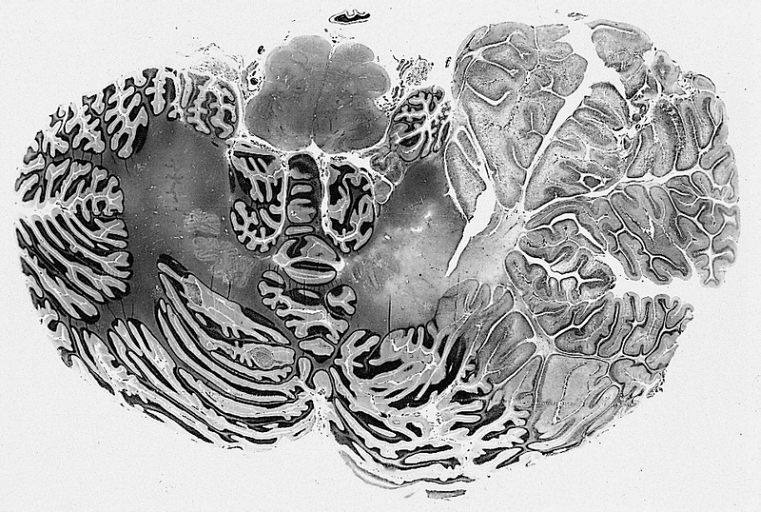Lhermitte–Duclos disease
Editor-In-Chief: Prab R Tumpati, MD
Obesity, Sleep & Internal medicine
Founder, WikiMD Wellnesspedia &
W8MD medical weight loss NYC and sleep center NYC
| Lhermitte–Duclos disease | |
|---|---|

| |
| Synonyms | Dysplastic gangliocytoma of the cerebellum |
| Pronounce | N/A |
| Specialty | N/A |
| Symptoms | Headache, ataxia, nausea, vomiting, visual disturbances |
| Complications | Hydrocephalus, increased intracranial pressure |
| Onset | Typically in adulthood |
| Duration | Chronic |
| Types | N/A |
| Causes | Genetic mutation |
| Risks | Associated with Cowden syndrome |
| Diagnosis | MRI, biopsy |
| Differential diagnosis | Cerebellar tumor, medulloblastoma, astrocytoma |
| Prevention | N/A |
| Treatment | Surgical resection, symptomatic treatment |
| Medication | Corticosteroids for edema |
| Prognosis | Variable, depends on size and location of the lesion |
| Frequency | Rare |
| Deaths | Rarely fatal |
Lhermitte–Duclos disease (LDD), also known as dysplastic gangliocytoma of the cerebellum, is a rare, slow-growing brain tumor that typically affects the cerebellum. It is characterized by an overgrowth of the ganglion cells in the cerebellar cortex, leading to a distinctive appearance on magnetic resonance imaging (MRI) scans.
Presentation[edit | edit source]
Patients with Lhermitte–Duclos disease often present with symptoms related to increased intracranial pressure due to the mass effect of the tumor. Common symptoms include headache, nausea, vomiting, ataxia, and visual disturbances. In some cases, patients may also experience seizures.
Pathophysiology[edit | edit source]
The exact cause of Lhermitte–Duclos disease is not well understood. However, it is believed to be associated with mutations in the PTEN gene, which is also implicated in Cowden syndrome. The overgrowth of ganglion cells leads to the characteristic thickening of the cerebellar folia, which can be observed on MRI as a "tiger-striped" pattern.
Diagnosis[edit | edit source]
Diagnosis of Lhermitte–Duclos disease is primarily based on imaging studies. MRI is the preferred modality, as it can reveal the distinctive striated appearance of the cerebellar cortex. Computed tomography (CT) scans may also be used, but they are less specific. A definitive diagnosis may require a biopsy to confirm the presence of dysplastic ganglion cells.
Treatment[edit | edit source]
Treatment options for Lhermitte–Duclos disease vary depending on the size and location of the tumor, as well as the severity of symptoms. Surgical resection is often the treatment of choice, especially in cases where the tumor is causing significant mass effect or symptoms. In some cases, radiotherapy or chemotherapy may be considered, although their effectiveness is less well established.
Prognosis[edit | edit source]
The prognosis for patients with Lhermitte–Duclos disease is generally favorable, especially if the tumor can be surgically resected. However, the risk of recurrence exists, and long-term follow-up with regular imaging studies is recommended.
Related Conditions[edit | edit source]
Lhermitte–Duclos disease is often associated with Cowden syndrome, a genetic disorder characterized by multiple noncancerous, tumor-like growths called hamartomas. Patients with Cowden syndrome have an increased risk of developing various types of cancer, including breast cancer, thyroid cancer, and endometrial cancer.
See Also[edit | edit source]
References[edit | edit source]
External Links[edit | edit source]
Search WikiMD
Ad.Tired of being Overweight? Try W8MD's physician weight loss program.
Semaglutide (Ozempic / Wegovy and Tirzepatide (Mounjaro / Zepbound) available.
Advertise on WikiMD
|
WikiMD's Wellness Encyclopedia |
| Let Food Be Thy Medicine Medicine Thy Food - Hippocrates |
Translate this page: - East Asian
中文,
日本,
한국어,
South Asian
हिन्दी,
தமிழ்,
తెలుగు,
Urdu,
ಕನ್ನಡ,
Southeast Asian
Indonesian,
Vietnamese,
Thai,
မြန်မာဘာသာ,
বাংলা
European
español,
Deutsch,
français,
Greek,
português do Brasil,
polski,
română,
русский,
Nederlands,
norsk,
svenska,
suomi,
Italian
Middle Eastern & African
عربى,
Turkish,
Persian,
Hebrew,
Afrikaans,
isiZulu,
Kiswahili,
Other
Bulgarian,
Hungarian,
Czech,
Swedish,
മലയാളം,
मराठी,
ਪੰਜਾਬੀ,
ગુજરાતી,
Portuguese,
Ukrainian
Medical Disclaimer: WikiMD is not a substitute for professional medical advice. The information on WikiMD is provided as an information resource only, may be incorrect, outdated or misleading, and is not to be used or relied on for any diagnostic or treatment purposes. Please consult your health care provider before making any healthcare decisions or for guidance about a specific medical condition. WikiMD expressly disclaims responsibility, and shall have no liability, for any damages, loss, injury, or liability whatsoever suffered as a result of your reliance on the information contained in this site. By visiting this site you agree to the foregoing terms and conditions, which may from time to time be changed or supplemented by WikiMD. If you do not agree to the foregoing terms and conditions, you should not enter or use this site. See full disclaimer.
Credits:Most images are courtesy of Wikimedia commons, and templates, categories Wikipedia, licensed under CC BY SA or similar.
Contributors: Prab R. Tumpati, MD

